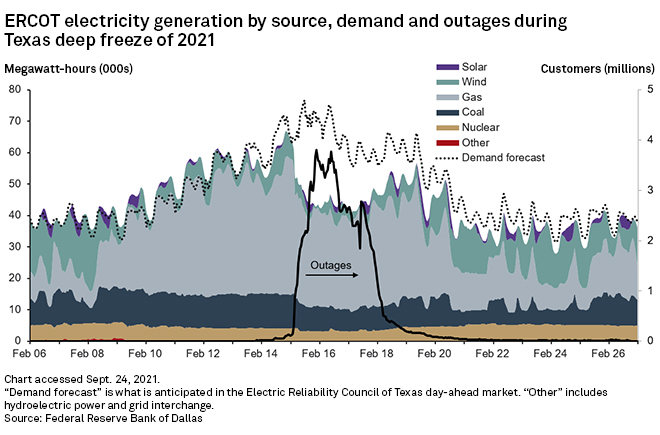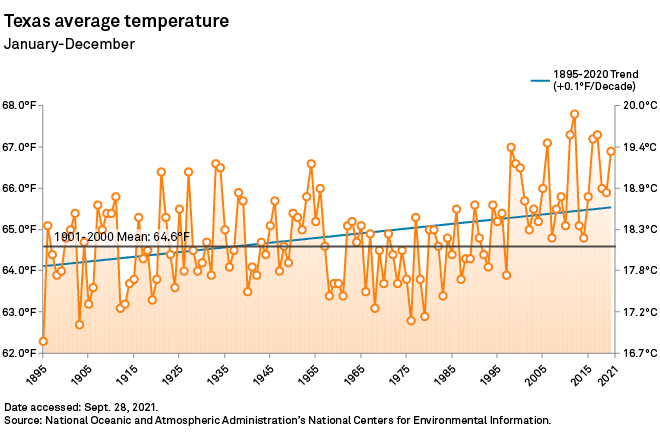S&P Global Offerings
Featured Topics
Featured Products
Events
S&P Global Offerings
Featured Topics
Featured Products
Events
S&P Global Offerings
Featured Topics
Featured Products
Events
Banking & Capital Markets
Economy & Finance
Energy Transition & Sustainability
Technology & Innovation
Podcasts & Newsletters
Banking & Capital Markets
Economy & Finance
Energy Transition & Sustainability
Technology & Innovation
Podcasts & Newsletters
S&P Global Offerings
Featured Topics
Featured Products
Events
1 Oct, 2021
|
Electricity service trucks line up in Fort Worth during the massive February winter storm, which brought historic cold weather and power outages to Texas. Source: Ron Jenkins/Getty Images News via Getty Images |
Seven months after a deadly Arctic blast nearly took down Texas' power grid, state and federal regulators are still trying to create rules to prevent another such disaster as winter approaches.
Federal officials said recently it will take years to update national standards for power plants to protect against severe weather. Texas state regulators have not finalized their beefed-up weatherization rules, mandated by the Legislature in the spring, leaving plant owners in limbo. Grid officials have said a study that will help regulators create the new rules will not be released until the end of January.
New standards for weatherizing natural gas facilities such as pipelines and wellheads, many of which failed to deliver fuel to power plants during the February blast, will not be finalized until two years after the storm triggered blackouts that led to hundreds of deaths in Texas. The timeline angered state lawmakers, who on Sept. 28 grilled Wei Wang, executive director of the Texas Railroad Commission, which is responsible for adopting the rules.
Lawmakers accused the Railroad Commission of creating a loophole for natural gas facility owners, who under a current proposal can submit a $150 application to opt out of being designated as critical infrastructure during weather emergencies.
"I recognize the urgency" of preparing the natural gas supply chain for the upcoming winter, Wang said at the hearing of the Senate Committee on Business and Commerce.
"I don't think you do!" replied Republican Sen. Donna Campbell, who threatened to fold the Railroad Commission into the Texas Public Utility Commission if the former does not hold the gas industry accountable.
PUC Chairman Peter Lake insisted the agency is moving forward with "substantial and rapid rulemaking."
"The bottom line is, we will be going into this winter with a more resilient grid than we had last winter," Lake told lawmakers.

Lone Star deadline looms
Lake said minimum requirements called phase one standards will be in place in November.
"If you're a generator and you're [tasked with] paying all this money for upgrades, and you don't know what all those upgrades will be ... that's kind of hard to implement," Caitlin Smith, an energy policy adviser who used to work for the Electric Reliability Council of Texas Inc.'s independent market monitor, said in an interview.
The PUC is reviewing public comments on the phase one rule proposal. The rules, if approved, would require power plant owners to fix "known, acute issues" that arose last winter. The PUC is also working on a rule that would raise the maximum fine for weatherization violations to $1 million per day.
Generators must attest to ERCOT in writing by Dec. 1 that they are in compliance. ERCOT must prioritize inspections of power plants based on risk. In a Sept. 29 email, an ERCOT spokesperson said it plans to review all generators' winter readiness reports, as well as inspect up to 250 generators, in December.
Plants "don't always build toward the worst-case scenario" because it is too expensive, Joshua Rhodes, founding partner of energy consulting firm IdeaSmiths LLC, said in an interview.
"Maybe you build toward the 95th percentile of the worst-case scenario," said Rhodes, who is also a researcher at the University of Texas at Austin. "Until we kind of have that defined, I don't know that we'll really be able to craft a coherent response or requirement or set of regulations."
Amanda Frazier, senior vice president of regulatory policy for Vistra Corp., told the Senate panel Sept. 28 that the company has already spent $50 million from its operating budget on weatherization and fuel storage for its natural gas plants. Vistra is the largest power plant owner in Texas, with more than 19,000 MW of winter nameplate capacity, according to S&P Global Market Intelligence data.
"We don't want Winter Storm Uri to happen to us again," Frazier said. "We lost a lot of money that week."
Texas regulators will rely on findings from a sweeping climate study as well as a federal probe to create more comprehensive weatherization standards in a second phase of rulemaking. Chris Coleman, senior meteorologist for ERCOT, is collecting about 100 years of data with more than 8,700 annual data points of hourly weather patterns in regions across the state.

Texas plants built for heat
Setting cold-weather standards is no easy task in a state that rarely experiences extreme winter weather. John Nielsen-Gammon, the Texas state climatologist and a professor of meteorology at Texas A&M, told commissioners in August that extreme heat is becoming hotter in Texas while extreme cold is becoming less intense.
"Our extreme cold temperatures come when we get cold weather from Canada and the Arctic," Nielsen-Gammon said. "And the Arctic is warming faster than the rest of the planet."
Power plants in Texas are built to withstand heat. Retrofitting them for protection against another winter storm could be costly, and it could come at the expense of operating less efficiently during sweltering summers.
General Electric Co. has roughly 7,000 wind turbines in the ERCOT region, Daniel Hynum, senior product manager for GE Renewable Energy, told regulators in August. About 6,000 of them have winter ice operation mode, which can change the pitch of blades as they accumulate ice. Far fewer — about 1,800 — also have a cold weather extreme package, which can extend turbine operations to minus 22 degrees F. Such packages employ a less brittle type of steel for towers and use heating elements for a turbine's lubrication systems, Hynum said.
But some weatherization packages limit a turbine's ability to operate during hot summers, Kirk Crews, vice president of business management for NextEra Energy Inc., told regulators. "And so it becomes a bit of a trade-off," Crews said.
Federal officials said 41,541 MW of wind power experienced unplanned outages or derates, constituting 22% of power losses during the freeze in Texas and the Midwest.
Focus on fuel security
Natural gas, the primary source of baseload generation, constituted 55% of outages and derates, with the storm knocking 106,568 MW of gas capacity off grids across the Midwest and Texas. Many natural gas facility owners failed to tell their utilities or ERCOT that they could serve as critical infrastructure during an emergency.
Lawmakers on Sept. 28 told Wang, the Railroad Commission director, to meet with the agency's general counsel to ensure that a current rule proposal would not allow natural gas companies to easily opt out of that designation. Wang reminded lawmakers that opting out is allowed by Senate Bill 3, a power market reform that Gov. Greg Abbott signed into law in June.
Federal investigators said Sept. 23 that "careful planning and coordination to manage the needs of the natural gas and electric systems in light of [their] 'interdependency' is important so that both systems are ultimately reliable for consumers, especially during cold weather conditions when the demand for natural gas and electricity are at their highest levels."
"It's one thing to weatherize a plant, and it's quite another to weather-secure your fuel — in other words, having fuel storage, whether it be gas storage or dual fuel capability," Nasi said in an interview. "All of the different storage options are expensive, and the market is going to need to be reformed to value that type of behavior."
Doug Lewin, an energy and climate consultant based in Austin, Texas, who has years of experience tracking PUC proceedings, said in an interview that the PUC could "create the greatest regulation for power plants ever written," but it would not matter if natural gas cannot be delivered to power plants.
"We will not have reliability in the wintertime if the PUC and Railroad Commission both are not regulating effectively," Lewin said.
'Wake-up call for all of us'
The Federal Energy Regulatory Commission and the North American Electric Reliability Corp. have issued a preliminary report from a joint inquiry into failures across the Midwest and Texas to provide power during the weeklong February freeze. Federal officials will release a final report in November.
"There was a similar inquiry after Texas experienced extreme cold weather in 2011, but those recommendations were not acted on. We can't allow this to happen again," FERC Chairman Richard Glick said in a Sept. 23 statement.
Glick called the preliminary findings "a wake-up call for all of us."
"This time, we must take these recommendations seriously, and act decisively, to ensure the bulk power system doesn't fail the next time extreme weather hits," Glick said. "I cannot, and will not, allow this to become yet another report that serves no purpose other than to gather dust on the shelf."
